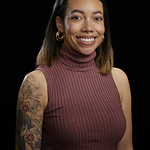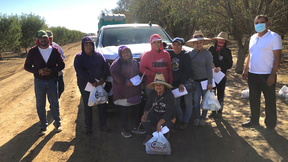STEM with Smartphones: Uncovering Unknown Capabilities
 (Download Image)
(Download Image)
A student uses their smartphone to illustrate the principle of color by addition. The smartphone is used as a light source to supply primary colored bars of light in order to study shadows appearing in secondary colors.
While most high schoolers are all too familiar with the utility of a smartphone, Dr. David Rakestraw recently hosted a workshop proving that their phones had more to offer than they ever thought possible. Building off his successful curricula designed for educators to exploit the incredible capabilities of smartphones in their high school and university classrooms, Rakestraw brought his signature enthusiasm for his subject directly to the students.
STEM with Smartphones took place June 12–16 and gathered 29 high schoolers from across the Bay Area at the Livermore Valley Open Campus. Participants were selected from a wide pool of applicants and were treated to hands-on experiments, facility tours, and opportunities to meet scientists from across the Laboratory.
Most of the workshop focused on hands-on STEM education activities, with Rakestraw and colleagues serving as teaching assistants roaming among tables to offer physics-related tips and guidance. Using multiple free downloadable applications, Rakestraw showed students how to take measurements with their phones’ built-in accelerometers, gyroscopes, magnetometers, barometric pressure transducers, microphones and more. Students were engaged and excited throughout the week-long workshop, often eager to share their new knowledge with friends and family.
Stan Hitomi, Math and Science Coordinator for the San Ramon Valley Unified School District and longtime science educator, served as one of Rakestraw’s teaching assistants. He was especially impressed by the students’ immediate application of the smartphone technology. “Since every student learns to work with the applications, it’s easy to extend what they learn here into their homes. We learned how to take data samples on heart cardiac cycle movement yesterday, and kids went home to practice with their parents and siblings and a few emailed [Dave Rakestraw] with their data at two o'clock in the morning! And Dave was so thrilled to talk about their findings when they all reconvened this morning because of course he had been up early checking email. Dave’s got a real passion for the work, and I think it's incredible.”
Students valued the hands-on approach of the workshop, noting that it was modeled differently from other educational experiences. Ethan noted, “I’m surprised by how committed everyone here is. People ask a lot of questions and everyone pays attention.”
Shivani elaborated, “I feel like in schools it’s just like read a textbook, take a test, next chapter. In here, it’s all about the experiments and getting to know about the real world. This is a unique experience. We’re not reading from a book and hearing a lecture every single day. It's more like getting to do it yourself and getting to know yourself.” Ashley concurred: “Dr. Rakestraw wouldn't just give us the answer. He made us discover it by ourselves, and it was easier to understand theories after we performed so many experiments.”
Beyond the new applications of smartphone measurement technology, several students claimed the opportunity to travel inside the Laboratory gates was a highlight of the week.
Shrui explained, “We talked about the fusion breakthrough at school, but I didn’t really understand how it actually worked. Getting a NIF tour and seeing exactly how they use the lasers, the glass, and how all the equipment is housed in such a huge building was really interesting.” Shivani agreed, “I feel like we got a lot of knowledge about the power our country holds and how we can advance in so many different ways.”
The week-long workshop opened the participants’ eyes to new education and career pathways. “This opened up more fields to me that I hadn't explored and it's actually really interesting. I was really pleasantly surprised about how much I liked it. And I'm definitely pursuing a STEM field in the future,” said Ashley.
Shivani agreed: “I've always been interested in astrophysics, and I feel like this program made me more excited for the future and encouraged me that I'm gonna have fun in what I'm learning.” Shivani and her cohort were also enthusiastic about recommending the workshop to fellow students. She explained, “I feel like this program should be a permanent thing because I learned so much. There’s so much in our smartphones and we just got to learn a tiny part of the complexity of our world.”
Ashley also hopes future participants will value the experience: “I would definitely recommend it to anybody whether they’re pursuing a STEM field or not, because I think this can pleasantly surprise you. Anyone can learn and absorb the knowledge of tons of very cool scientists here.”
You can learn more about Dave Rakestraw’s Physics with Phones curriculum here and find future opportunities for STEM education here.
—Stephanie Turza
Workshop participants work through an activity with their smartphones and other household items.
Contact
 Lauren Casonhua
Lauren Casonhua
[email protected]
(925) 423-3141
Related Links
Physics with PhonesScience Education
Tags
Community OutreachFeatured Articles








